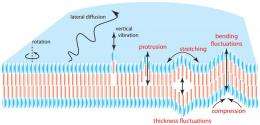Long-predicted fluctuations in cell membranes observed for first time

(Phys.org) -- A long-standing mystery in cell biology may be closer to a solution thanks to measurements taken at the National Institute of Standards and Technology (NIST) and France's Institut Laue-Langevin (ILL), where scientists have observed changes in the thickness of a model cell membrane for the first time. The findings, which confirm that long-predicted fluctuations occur in the membranes, may help biologists understand many basic cellular functions, including how membranes form pores.
Every cell in your body is surrounded by a cell membrane, a thin, flexible wall made of fatty molecules that maintains the integrity of the nucleus and the rest of the cell's interior. Cells need a way to take in nutrients and expel waste across the membrane, and generally this involves lodging special proteins in the membrane. These proteins form holes that can open and close, acting as gateways to the interior.
Before these proteins take their place in the membrane, they float freely about the cell's protoplasm. But just how the membrane—whose job, after all, is to form an otherwise impermeable barrier—allows these proteins to penetrate it in the first place is largely a mystery, though one clue might lie in its dynamic nature.
"The cell membrane is not a static barrier. It's always moving, its thickness fluctuating and waves rippling through it," says Michihiro Nagao of the NIST Center for Neutron Research (NCNR). "Some theories indicate that if a protein is near the interior of the membrane when it is moving in just the right way, this movement might allow the protein to work its way in somehow."
The research team constructed a set of artificial membranes and analyzed their movement with a spin echo machine, a very specialized device of which there are only a few in the world. After a lengthy measurement effort, the team eventually found that when warmed to around body temperature, the membrane thickness fluctuated by up to 8 percent roughly every 100 nanoseconds, or 30 times slower than for comparable nonbiological sheets.
"Some theories indicate that some form of motion like this must be happening for pores to form, so it's exciting to actually see them," says Paul Butler, also of the NCNR.
It will take time to understand completely the cause of the fluctuations, why they are so slow, and how they enable protein insertion, but Butler points out that knowledge of the speed and size of the fluctuations will be helpful in designing therapies to control dysfunction in membrane permeability, including the creation of undesirable pores that lead to cell death.
"This research gives us a tool with which we can measure the effect of potential therapeutic agents on the thickness fluctuations," Butler adds.
The operation of the instrument at NIST is funded in part by the National Science Foundation.
More information: *A.C. Woodka, P.D. Butler, L. Porcar, B. Farago and M. Nagao. Lipid bilayers and membrane dynamics: Insight into thickness fluctuations. Physical Review Letters, DOI: 10.1103/PhysRevLett.109.058102 , Vol. 9, Issue 5, Aug. 3, 2012.
Journal information: Physical Review Letters
Provided by National Institute of Standards and Technology


















